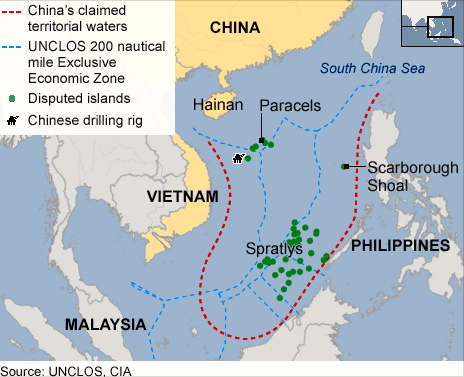The submarine force of any navy is the strategic non-nuclear capability which acts as a serious deterrent before any naval military manoeuvres and outcome is calculated. The role of the largest Commonwealth nation in the region is being measured on its submarine force capability.
The Diplomat story:
Australia’s Submarine Debate: Shipyards and Seas
The debate often misses the regional context surrounding Australia’s submarine program.
By Helen Clark
October 13, 2015What’s being left out of Australia’s submarine and naval security debate? The region those subs will be patrolling.
In terms of defense news, the submarine debate on who will build Australia’s new fleet, and where it will be built, has had some staying power. However, the mainstream debate has not really looked at changes in the region. Many countries in the Asia-Pacific are now pursuing their own submarine plans, and nuclear-capable submarines in the Indian Ocean are not far away.
The South China Sea is a focus for new Prime Minister Malcolm Turnbull but the recent drill with India hasn’t received a lot of attention in the Australian press. What else is happening in the region, and what might that mean for future submarine and naval plans.
China and South China Sea a Priority
Turnbull gave his first serious interview on September 21. He spoke about domestic and foreign policy. ISIS, of course, remains a threat. But Turnbull has also come out strongly against China “pushing the envelope” in the South China Sea and suggested it is pushing regional instability whilst also ensuring a greater U.S. presence in the area, something that would seem contrary to Chinese interests.
How will this affect Australia and what will Australia’s role be in one of the busiest and most contested waters?
On this Turnbull was a little less clear: “Well our Defence Force has – and this is not a revelation … Our Defence Forces have to be able to play a role in a range of different potential conflict situations. But, you know, we’re not – we’re not seeking to, um, ah – I don’t want to – no-one – no-one, least of all the Australian Government, wants to exacerbate situations.”
Turnbull is right that China’s actions seems to be driving a greater U.S. presence and closer relations between it and certain nations.
He name checked the closer Vietnam-U.S. relationship. According to this mid-2014 piece from HIS Jane’s territorial disputes in the Asia-Pacific and “continued concerns over China’s military development – are driving defence spending across the region.
This has been characterised by some as an arms race, although it may be better viewed as a region-wide materiel upgrade propelled by resource competition, rising government revenues and declining markets elsewhere in the world.”
At the same time, both China and India are moving closer to having nuclear-capable submarines patrol the Indo-Pacific, and India and Australia are keen on naval exercises. Australia, in fact, wishes to participate in the Malabar exercises with India, the U.S. and Japan; Australia withdrew from those exercises in 2008.
The View in Australia, SEA 1000, etc.
China is a factor in many Australian plans, both economic and defense. China will also factor in the upcoming defense White Paper, which was delayed after former Prime Minister Tony Abbott’s shipbuilding announcement and may now make it out in October or November.
The Competitive Evaluation Process (CEP) between Japan, Germany and France and the issue over local build is front and center in the debate on the future submarine fleet. Sweden, which built the six Collins-class submarines the Royal Australian Navy currently operates, was ruled out early, to their and others’ surprise.
Japan was picked earlier, for strategic and alliance reasons, but the up and downsides remain, on a purely technical level, complex. Australia, with its enormous coastline, has special needs and can’t simply chose an off-the-rack purchase, even if domestic politics was not such an important factor.
The Australian Strategic Policy Institute has been running an excellent series on this on their Strategist blog, profiling the three nations and nearly every other aspect of the submarine process. The Kockums-built Collins-class were designed with Australian needs in mind, both the large coastline and a deterrence-based defense policy.
Though sometimes maligned, they are among the quietest and least detectable subs in operation. The question won’t be decided this year and new Defense Minister Marise Payne has already said she won’t be drawn into debate at this stage.
The CEP is politically loaded, of course, and Tony Abbott’s announcements of a A$90 billion ($65.6 billion) naval ship and submarine build and 2000 jobs for South Australia early last month were called a first “election salvo.”
A paper from the Defence Minister said in February, “Submarines are the most complex, sensitive and expensive Defence capability acquisition a Government can make.”
The go-or-no dogfighting capabilities of the F-35 pale in comparison to the complexities of a submarine fleet, especially one built for Australia’s unique needs. The winner of the CEP will have to build as much of the new fleet in Australia as possible, despite the poor report on the Air Warfare Destroyers and a lengthy report by RAND Corp commissioned by the Australian government earlier this year on the naval shipbuilding capabilities of the three main shipyards that suggested they were not quite competitive or effective enough.
One of the talking points of the Japanese Soryu-class, which former Abbott was earlier suggesting Australia should buy off-the-rack, was that it might have shored up something of a trilateral alliance between Australia, the U.S. and Japan.
The U.S. was certainly happy with the Soryu idea. Aussies however, were not remotely happy with the idea of coming to the aid of Japan should any conflict with China arise.
Ankit Panda has a more up-to-date analysis on what Malcolm Turnbull might mean for a Japanese sub-build.
The Missing Piece of the Debate
So far, so much the same ground covered. All this has been the view from Australia since last year. But the rest of the region is also engaged in its own submarine race. Politicians aren’t talking about that as much, outside of Turnbull’s South China Sea comments.
Vietnam has now taken possession of its six new Kilo-class Russian-made submarines, ordered in 2009. Vietnam also wants naval assistance from Washington, with President Truong Tan Sang saying during Ashton Carter’s June visit that he would like Washington to “provide all necessary assistance to Vietnam in raising the capacity of maritime law enforcement forces.”
Indonesia is now looking at Russian subs of its own, preferring when the budget allows it, to buy new and no longer second hand. More broadly, Indonesia wishes to increase its naval presence in the region. Thailand has been wanting submarine capability for a long time but has delayed purchase again after finally plumping for three Chinese-built subs. As Prashanth Parameswaran has noted, the Chinese option was unexpected, “given the significance of the purchase, the Thai military’s preference for Western equipment which was also on offer, and well-known suspicions about the reliability of submarines from Beijing….”
At the same time this worthwhile paper from the Lowy Institute has noted that China and India are moving to the test phase of their nuclear-armed submarines, which will patrol the Indo-Pacific, and discusses what that might mean for stability. China can apparently already put a nuclear-capable submarine out to sea with weapons. “Advocates of sea-based nuclear weapons see such fleets as providing stability because of their relative invulnerability to surprise attack… This was certainly the case during the Cold War. But what applied in the 20th century struggle between the West and the Soviet Union does not necessarily hold for the more complex strategic situation that is now evolving in Asia.” The security environment is changing rapidly, in other words.
The majority of Australia’s trade goes through an area already patrolled by half the world’s submarines, and with plans afoot for more in many nations this will increase.
Australia is concerned enough to have been involved in its first-ever war games with India, ones which had a submarine focus, which apparently unsettled the Chinese. Captain Sheldon Williams, defense advisor at the Australian High Commission in New Delhi told Bloomberg last month, that there is “potential for increased security tensions in the Indian Ocean.. We sit right in the confluence of the Indian and Pacific Oceans. We have a significant responsibility for its security. That’s how we’re looking at it now.”
Australia and India both have a stake in Chinese nuclear-capable submarines in the Indian Ocean. Australia has also requested to join the Malabar Exercise between India, the U.S. and Japan, though actually pulled out in 2008 under Kevin Rudd.
These wider strategic moves do not always make it into public debate over the circumstances Australian submarines might face. What would closer ties or a “democratic security diamond” (as Shinzo Abe has said of the Japan-U.S.-India-Australia quadrilateral arrangement) mean?
Would the pick of a customized Soryu be a good option for those reasons? What is Australia’s perception of these shifts in the security environment? Much may be cleared up once the White Paper finally arrives, but until then the debate will stick to shipyards and not seas.
************
Again, Australian naval operations take into consideration the development is South East Asia where China is staking a claim for the ‘Nine-Dash-Line’, in a multinational dispute of territorial waters.

China encroaching into neighbours EEZ territories as defined by UNCLOS (1982) and relationship is sliding downwards
The South China Sea is the second most busiest and important merchant shipping waterway, on top of the rich hydrocarbon deposits. Both are within the ambit of China’s interest to have access to and control.
The ability to project force between the major naval powers in the region is not primarily for the South China Sea alone, but all the way across the vast Indian Ocean.
The projecting of force with effective submarine capability would provide an added burden to the potential aggressor. It is as when the risk is calculated, the potency of a submarine is equal to ten surface combat vessel.
It is very important for Malaysia to continue having a strong naval force with even more potent submarine force. Considering as maritime state Malaysia is dependent to sea for trade, food and other essential imports, the ability to project force is deemed necessary when the need arises.
It was a strategic decision to acquire the Perdana Class Scorpene submarines. However, it was heavily politicised with really bad demonisation-intent after tones.
In the interest of trade growth and stepping into a developed nation status, Malaysia should be moving forward by acquisition of more assets to improve the potency of the submarine force of the Royal Malaysian Navy and not pander to pessimism and lies and regress.








Australia has always been an exemplary nation, always playing its role in the Commonwealth and in the world body of nations, be it in Gallipoli in the Turkish peninsular in World War I, in South East Asia in World War II, in Korea and Vietnam thereafter.
It also helped Malaysia in the undeclared war called Confrontation, waged by the then maddening Indonesian President Sukarno. It’s always comforting to have Australia as a fellow member of the Commonwealth and as the largest country in this region, having practically similar values as us in Malaysia as far as the defence of the democratic way of life is concerned.
One wishes that Australia is well populated with a large population that’ll enable it to become even a World Power. Australia should be taking more refugees that Europe has been deluged with in recent times. Bigger populated, it would have bigger manpower and an enlarged economy to afford a stronger military; it would then provide us a better sense of security, especially when Britain is far away and even cutting down their defence expenditures, despite the opposition by the retired military top brass and the private feelings of those still in service. The recent Russian flights over the English Channel and the North Sea during a British military exercise must have evoked such feelings and grumblings.
Australia may not be having military capability equal to that of the British, But they should have one that’ll be able to help contain any armed conflict in the South China Sea before the big powers like US and Britain arrive. US has, after Vietnam, looked at Australia as a new line of defence to their interests in this region. Yes, now let’s have a closer look at the Australian naval facilities and hardware.
Berita Menteri Pertahanan DS Hishammuddin di Beijing nak adakan kerjasama tentera antara Malaysia dan China tu tak tau berapa faedah nya kpd Malaysia. Bukan kah memberi peluang tentea China tahu dengan mendalam SOP kita bila ada pencerobohan ke “territorial waters” kita?
China, Malaysia pledge to deepen military cooperation
Xinhua – 2 hours ago
Vice chairman of China’s Central Military Commission Fan Changlong shakes hands with Malaysian Defense Minister Hishammuddin Hussein in Beijing, China, Oct. 15, 2015.
Submarines – Malaysia has 2, Singapore, a small island state, has 2 (is it more?), Australia, the largest country in this region (it’s a sub-continent for goodness sake) has 6 Collins class Australian-built diesel-electric submarines. To be replaced via a current tender exercise. And don’t know how many units their budget of A$90 billion (US$65.6 billion) will fetch, bearing in mind that submarines are damn expensive to build.
Howda. Vietnam has now taken possession of its six new Kilo-class Russian-made submarines. Indonesia has only second hand subs. Thailand has decided to purchase three Chinese-built subs. But, in the light of China being the source of potential conflict in the South China Sea, what use would they be – in the event of flare ups, supply of spare parts would simply be withheld.
I am not confident. Of course I rely only on numbers, not knowing the strike capability of whatever non-Chinese subs are around in this region. Yes, subs act as a “serious deterrent before any naval military manoeuvres”, but if they are torpedoed or chased out, the Chinese PLA subs will hold sway.
Back to dependence on the US nuclear subs plying the South China Sea. Maybe we’d be comforted by US strength if the ever self-promoting loud-mouthed Republican candidate Donald Trump becomes President. Or the whole world perish by nuclear war that erupts by his usual cocky talk of US superiority.
Not bad for Vietnam. We can have some comfort from Vietnamese capability in thwarting the Chinese menace in the South China Sea.
Vietnam has had strong links with Russia since after World War II. During the Vietnam War, Russia has air and naval bases in North Vietnam. In recent times, Russia has been “restocking Vietnam’s Subs, Ships, Sukhois And More…” – http://www.defenseindustrydaily.com/vietnam-reportedly-set-to-buy-russian-kilo-class-subs-05396/
Britain does not look a formidable Super Power when they started playing a lesser role after Iraq War, now no longer having troops in Afghanistan and Obama had just announced retention of about 5,000 troops until after he leaves the Presidency next year to help the beleaguered Afghanistan troops against resurging Taliban attacks like in Kundoz recently.
There have even been talk of decommissioning their nuclear submarine to save annual running and maintenance costs. So, how to rely on Britain being able to help patrol the South China Sea quietly.
Our hope therefore is for the new Australian submarines to help contain any Chinese naval threat, though it’ll take at least 1-2 years to build and commission. Meanwhile, the US nuclear and conventional submarines will presumably continue patrolling those waters and, hopefully, their aircraft carriers, too.
Remember, the airstrip the Chinese have been building on the island near to those the Philippines and Vietnam have claimed will be ready for the stationing of their fighter jets soon. Nasty intentions, the PLA Navy and Military.